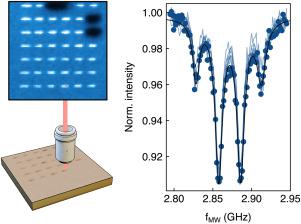Nitrogen-vacancy centre formation via local femto-second laser annealing of diamond
IF 11.6
2区 材料科学
Q1 CHEMISTRY, PHYSICAL
引用次数: 0
Abstract
Emerging quantum technologies based on the nitrogen-vacancy (NV) centre in diamond require carefully engineered material with controlled defect density, optimised NV formation processes, and minimal crystal strain. The choice of NV generation technique plays a crucial role in determining the quality and performance of these centres. In this work, we investigate NV centre formation in nitrogen-doped diamond using femtosecond (fs) laser processing. We systematically examine the effect of laser pulse energy on NV production and quality using photoluminescence and optically detected magnetic resonance measurements. We also probe the role of pre-existing lattice defects formed by electron irradiation and consider defect evolution over extended dwell times. Finally, we are able to identify a regime where the main action of the fs-laser is to diffuse rather than create vacancies. This local annealing capability expands the toolkit for tailored NV production and presents opportunities for fine tuning defect populations.

金刚石飞秒激光局部退火氮空位中心的形成
基于金刚石氮空位(NV)中心的新兴量子技术需要精心设计的材料,控制缺陷密度,优化NV形成过程和最小的晶体应变。NV生成技术的选择在决定这些中心的质量和性能方面起着至关重要的作用。在这项工作中,我们利用飞秒激光加工研究了氮掺杂金刚石中NV中心的形成。我们系统地研究了激光脉冲能量对NV生产和质量的影响,使用光致发光和光学检测磁共振测量。我们还探讨了由电子辐照形成的预先存在的晶格缺陷的作用,并考虑了在延长的停留时间内缺陷的演变。最后,我们能够确定一个机制,其中fs激光的主要作用是扩散而不是产生空位。这种局部退火能力扩展了定制NV生产的工具包,并提供了微调缺陷数量的机会。
本文章由计算机程序翻译,如有差异,请以英文原文为准。
求助全文
约1分钟内获得全文
求助全文
来源期刊

Carbon
工程技术-材料科学:综合
CiteScore
20.80
自引率
7.30%
发文量
0
审稿时长
23 days
期刊介绍:
The journal Carbon is an international multidisciplinary forum for communicating scientific advances in the field of carbon materials. It reports new findings related to the formation, structure, properties, behaviors, and technological applications of carbons. Carbons are a broad class of ordered or disordered solid phases composed primarily of elemental carbon, including but not limited to carbon black, carbon fibers and filaments, carbon nanotubes, diamond and diamond-like carbon, fullerenes, glassy carbon, graphite, graphene, graphene-oxide, porous carbons, pyrolytic carbon, and other sp2 and non-sp2 hybridized carbon systems. Carbon is the companion title to the open access journal Carbon Trends. Relevant application areas for carbon materials include biology and medicine, catalysis, electronic, optoelectronic, spintronic, high-frequency, and photonic devices, energy storage and conversion systems, environmental applications and water treatment, smart materials and systems, and structural and thermal applications.
 求助内容:
求助内容: 应助结果提醒方式:
应助结果提醒方式:


